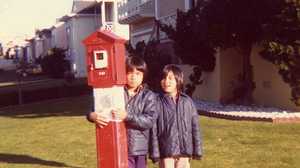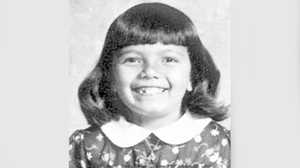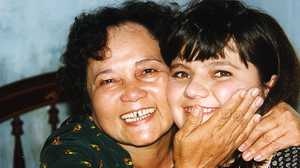Operation Babylift (1975)

A U.S government plan to transport Vietnamese orphans out of their war-torn country began in disaster. The very first flight to leave Saigon, on April 4, 1975, crashed several minutes after takeoff, killing 138 people, most of whom were Vietnamese children. Critics in Washington questioned the Ford administration's political motivations. Others criticized the government for assuming that the children would be better off in America. But perhaps most disturbing was that many of the children were not orphans at all.
During the final days of the Vietnam War, the U.S. government began boarding Vietnamese children onto military transport planes bound for adoption by American, Canadian, European and Australian families. Over the next several weeks, Operation Babylift brought more than 3300 children out of Vietnam.
As the Communists advanced into South Vietnam, rumors about what they would do were rampant. Many South Vietnamese were desparate to escape. Children fathered by American soldiers were rumored to be in particular danger. Heidi Bub's birth mother, Mai Thi Kim, feared that her daughter would "be soaked with gasoline and be burnt." For a mother desperate to protect her mixed race child in the face of an advancing enemy, a chance to send the child to America was a ray of hope.
From the start, Americans debated the Babylift's purpose, execution and justification. American Ambassador to Vietnam Graham Martin claimed that the evacuation "would help reverse the current of American public opinion to the advantage of the Republic of Vietnam." President Gerald Ford made use of the photo opportunity, standing before television cameras on the tarmac at San Francisco airport to meet a plane full of infants and children.
Bay Area attorney Tom Miller, who would become involved in litigation over the Babylift, called it "one of the last desperate attempts to get sympathy for the war." A Congressional investigation suggested that there was "a total lack of planning by federal and private agencies." Newspaper headlines asked, "Babylift or babysnatch?" and "The Orphans: Saved or Lost?" And a Vietnamese orphan character appeared in the satirical "Doonesbury" cartoons of G. B. Trudeau.
Some Americans asked whether fear made it right to take children from their homeland. A Vietnamese American journalist, Tran Tuong Nhu, wondered, "What is this terror Americans feel that my people will devour children?" Some felt that guilt may have been a motivation. Relief agencies in Vietnam were accused of being "Saigon's baby business." The New York Times quoted a Yale psychologist, Dr. Edward Zigler, who said: "We've been ripping [the children of the airlift] right out of their culture, their community... it's some kind of emotional jag we are on."
There were some Americans who welcomed the Babylift, including American aid workers in South Vietnam. Sister Susan McDonald cared for 100 infants at a Saigon orphanage. As the North Vietnamese moved closer to the city, living conditions worsened. Food was in very short supply, and gasoline was so expensive that McDonald would buy it by the quart. The orphanage depended on supplies from overseas, and when these -- including food -- were no longer forthcoming, the children's lives were at risk. McDonald had been looking for a flight to move the children in her care to safety, but commercial flights had ceased. When the military invited her to participate in Operation Babylift, she gratefully accepted.
On April 26, 1975, McDonald boarded a plane with 200 Vietnamese children and 14 caretakers. The plane stopped in the Philippines to get the sickest children to a hospital, and after more than a week in a refugee camp, the rest of the children continued their journey in a seated cargo plane. The babies were placed in small cardboard boxes lined with blankets. The two hundred children landed in Seattle at the end of a long and strange journey.
Tran Tuong Nhu, one of a small number of Vietnamese Americans living in the Bay Area at the time, volunteered to assist with Babylift arrivals in San Francisco's Presidio. She and the other volunteers were surprised to hear children talking about their living family members. Many of the children did not appear to be orphans at all.
Nhu, Miller, and others approached the federal government and adoption agencies with their concerns about the situation. When they received no response, they contacted the Center for Constitutional Rights and filed a lawsuit against Secretary of State Henry Kissinger, the federal government, and the adoption agencies.
In Vietnam, poor families would sometimes place children in orphanages if they could not feed them. But in such cases, parents did not intend to give them up, and would often visit their children. Many parents, especially of Amerasians, were concerned about their children's safety. In some cases, parents put their children on a Babylift plane, and later left Vietnam themselves as refugees, with the intention of finding their children later. "Many of [the adoption records] lacked the consents from the parents," said Miller. When Mai Thi Kim brought her daughter Hiep (Heidi Bub) to the Holt Adoption Agency in Danang, she was given no papers whatsoever.
A worker with the U.S. Agency for International Development in Saigon, Bobby Nofflet, recalled the tumultuous days of Babylift: "There were large sheaves of papers and batches of babies. Who knew which belonged to which?"
The Babylift lawsuit argued that many of the children in the airlift were not orphans, had been given up under duress during wartime, and that the U.S. government had an obligation to return them to their families. Attorney Tom Miller said that he brought Vietnamese birth parents into the courtroom to plead for their children, but to no avail. Judge Spencer Williams eventually threw out the Babylift case, declaring it to be 2,000 separate cases, and not a class action suit. "He sealed the records, and told us we could not contact any of the Vietnamese families and let them know where their children were," said Miller.
Only in cases where parents had found their children independently could Miller's group represent them. Eventually only twelve children were reunited with their Vietnamese parents, but only after many years and lawsuits. Many children were caught in court battles between their birth parents and their adoptive parents.
For a number of Babylift adoptees, finding their birth parents is essentially impossible, because no records exist. In recent years, many have established connections with each other based on their shared experiences.







